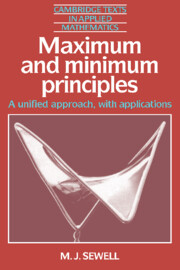2 - Duality and Legendre transformations
Published online by Cambridge University Press: 12 October 2009
Summary
Introduction
The main purpose of this chapter is to give a very explicit account of the Legendre transformation, including information which is not widely known. We work in finite dimensions only, and to that extent the treatment is elementary. Basic properties of the transformation are laid out in §2.2. Detailed illustrations are given in §§2.3 and 2.4 for functions of one and two variables respectively.
The transformation may be viewed as a conversion of one continuous scalar function into another. Under quite light restrictions it turns out that the transformation is reversible, and then we say that each function is the dual of the other, or that each is the Legendre transform of the other. The reversible Legendre transformation is also called the Legendre dual transformation. It is important for both practical and theoretical reasons.
On the practical side we can often expect to solve at least some of the constraints governing a problem, whether it be only a stationary value problem or, more strongly, a problem offering an upper bound to be evaluated prior to minimization. The Legendre transformation is one of the devices which can effect the solution of such partial constraints. This can be explained in the notation of the very particular examples of the transformation already used to facilitate the proofs of Theorems 1.3(b) and 1.9(a) (see also Exercises 1.3). The dual functions there, for example J[u] and G[υ] in (1.34), have the properties υ = J′[u] and u = G′[υ] where the prime denotes the gradient.
- Type
- Chapter
- Information
- Maximum and Minimum PrinciplesA Unified Approach with Applications, pp. 93 - 187Publisher: Cambridge University PressPrint publication year: 1987

